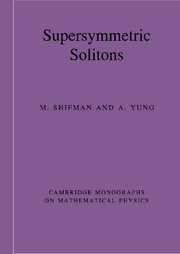Book contents
- Frontmatter
- Contents
- Acknowledgments
- List of abbreviations
- 1 Introduction
- I SHORT EXCURSION
- II LONG JOURNEY
- Introduction to Part II
- 4 Non-Abelian strings
- 5 Less supersymmetry
- 6 Non-BPS non-Abelian strings
- 7 Strings on the Higgs branches
- 8 Domain walls as D-brane prototypes
- 9 Wall-string junctions
- 10 Conclusions
- Appendix A Conventions and notation
- Appendix B Many faces of two-dimensional supersymmetric CP(N – 1) model
- Appendix C Strings in N = 2 SQED
- References
- Index
- Author index
7 - Strings on the Higgs branches
from II - LONG JOURNEY
Published online by Cambridge University Press: 28 July 2009
- Frontmatter
- Contents
- Acknowledgments
- List of abbreviations
- 1 Introduction
- I SHORT EXCURSION
- II LONG JOURNEY
- Introduction to Part II
- 4 Non-Abelian strings
- 5 Less supersymmetry
- 6 Non-BPS non-Abelian strings
- 7 Strings on the Higgs branches
- 8 Domain walls as D-brane prototypes
- 9 Wall-string junctions
- 10 Conclusions
- Appendix A Conventions and notation
- Appendix B Many faces of two-dimensional supersymmetric CP(N – 1) model
- Appendix C Strings in N = 2 SQED
- References
- Index
- Author index
Summary
One common feature of supersymmetric gauge theories is the presence of moduli spaces – manifolds on which scalar fields can develop arbitrary VEVs without violating the zero energy condition. If on these vacuum manifolds the gauge group is broken, either completely or partially, down to a discrete subgroup, these manifolds are referred to as the Higgs branches.
One may pose a question: what happens with the flux tubes and confinement in theories with the Higgs branches? The Higgs branch represents an extreme case of type-I superconductivity, with vanishing Higgs mass. One may ask oneself whether or not the ANO strings still exist in this case, and if yes, whether they provide confinement for external heavy sources.
This question was posed and studied first in [102] where the authors concluded that the vortices do not exist on the Higgs branches due to infrared problems. In Refs. [211, 212] the N = 1 SQED vortices were further analyzed. It was found that at a generic point on the Higgs branch strings are unstable. The only vacuum which supports string solutions is the base point of the Higgs branch where the strings become BPS-saturated. The so-called “vacuum selection rule” was put forward in [211, 212] to ensure this property.
On the other hand, in [103, 175] it was shown that infrared problems can be avoided provided certain infrared regularizations are applied.
- Type
- Chapter
- Information
- Supersymmetric Solitons , pp. 188 - 195Publisher: Cambridge University PressPrint publication year: 2009



